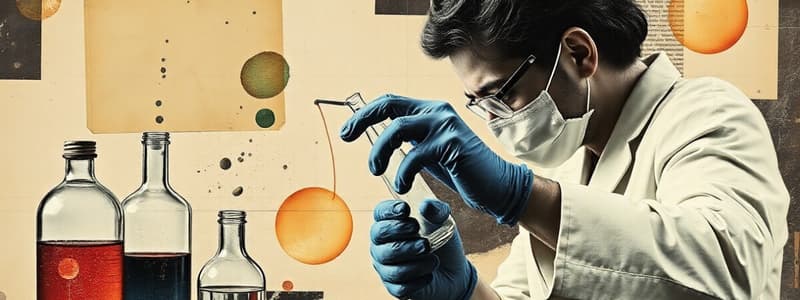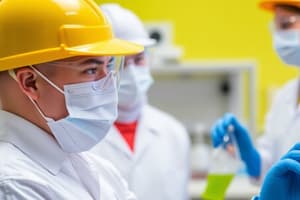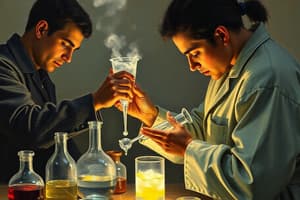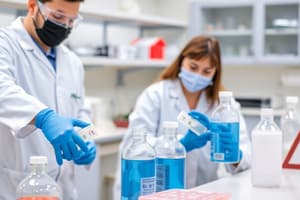Podcast
Questions and Answers
What is a key requirement for footwear in the lab?
What is a key requirement for footwear in the lab?
- Shoes do not need to fit snugly.
- Shoes must completely cover the foot. (correct)
- Open-toed shoes are acceptable.
- Any type of shoes can be worn.
What action should NEVER be taken when you spill lab chemicals on yourself?
What action should NEVER be taken when you spill lab chemicals on yourself?
- Wipe the area with a cloth. (correct)
- Notify the teacher immediately.
- Rinse the affected area with water.
- Leave the lab to wash your hands.
What should you do with broken glass or metal in the lab?
What should you do with broken glass or metal in the lab?
- Put it in the trash can.
- Leave it on the table.
- Store it in a safe place until cleanup.
- Notify the instructor for proper disposal. (correct)
Which of the following is NOT recommended when working in the lab?
Which of the following is NOT recommended when working in the lab?
What term describes prolonged exposure to harmful substances?
What term describes prolonged exposure to harmful substances?
Why should you clean up spilled substances immediately?
Why should you clean up spilled substances immediately?
What should be done if a fire breaks out in the lab?
What should be done if a fire breaks out in the lab?
Which of the following safety equipment is NOT mentioned as being accessible in the lab?
Which of the following safety equipment is NOT mentioned as being accessible in the lab?
What is the primary reason for neutralizing an acid spill with a basic solution?
What is the primary reason for neutralizing an acid spill with a basic solution?
What precaution should be taken when pouring chemicals into a test tube held in your hand?
What precaution should be taken when pouring chemicals into a test tube held in your hand?
What should you do if you accidentally take too much of a reagent?
What should you do if you accidentally take too much of a reagent?
Which of the following scenarios demonstrates an unsafe way to pour chemicals?
Which of the following scenarios demonstrates an unsafe way to pour chemicals?
Why should you listen to the teacher's instructions during a lab?
Why should you listen to the teacher's instructions during a lab?
What is the main reason for obtaining precise measurements at eye level while pouring chemicals?
What is the main reason for obtaining precise measurements at eye level while pouring chemicals?
What is the primary concern when a break in glassware is observed during a chemical pour?
What is the primary concern when a break in glassware is observed during a chemical pour?
What is the main reason for avoiding pouring chemicals into containers held in your hands?
What is the main reason for avoiding pouring chemicals into containers held in your hands?
Which of the following is a mandatory safety equipment item in the lab?
Which of the following is a mandatory safety equipment item in the lab?
What is the purpose of wearing a lab coat during experiments?
What is the purpose of wearing a lab coat during experiments?
Why is it discouraged to wear contact lenses in the lab?
Why is it discouraged to wear contact lenses in the lab?
Which of the following statements about eating and drinking in the lab is true?
Which of the following statements about eating and drinking in the lab is true?
What is the proper way to wear safety glasses in the lab?
What is the proper way to wear safety glasses in the lab?
When are gloves necessary in the lab?
When are gloves necessary in the lab?
What is a key reason for the safety rule of not tasting substances in the lab?
What is a key reason for the safety rule of not tasting substances in the lab?
Why is closed-toe footwear required in the lab?
Why is closed-toe footwear required in the lab?
What is a potential risk of consuming food or drinks in the lab?
What is a potential risk of consuming food or drinks in the lab?
What should be done with leftover chemicals once taken from their original container?
What should be done with leftover chemicals once taken from their original container?
Why is it important to wash your hands at the end of the lab activity?
Why is it important to wash your hands at the end of the lab activity?
What could happen if leftover chemicals are poured down the drain without dilution?
What could happen if leftover chemicals are poured down the drain without dilution?
What is a consequence of keeping other items on your lab bench?
What is a consequence of keeping other items on your lab bench?
When is it necessary to wash your hands immediately during a lab activity?
When is it necessary to wash your hands immediately during a lab activity?
Why should one consult the teacher before cleaning up in the lab?
Why should one consult the teacher before cleaning up in the lab?
What should you do if you realize there is gum in your mouth while in the lab?
What should you do if you realize there is gum in your mouth while in the lab?
What should be done immediately if your eyes are exposed to a hazardous chemical?
What should be done immediately if your eyes are exposed to a hazardous chemical?
When using a Bunsen burner, what precaution is necessary regarding hair?
When using a Bunsen burner, what precaution is necessary regarding hair?
What is the primary function of a graduated cylinder in the laboratory?
What is the primary function of a graduated cylinder in the laboratory?
How should you respond to a large cut in a laboratory setting?
How should you respond to a large cut in a laboratory setting?
Which laboratory equipment is designed specifically to hold a test tube during heating?
Which laboratory equipment is designed specifically to hold a test tube during heating?
What is a potential consequence of not listening to the teacher's instructions?
What is a potential consequence of not listening to the teacher's instructions?
Why is it important to label containers in the lab?
Why is it important to label containers in the lab?
What should you do first if you break glassware in the lab?
What should you do first if you break glassware in the lab?
How should you safely detect the odor of a chemical?
How should you safely detect the odor of a chemical?
What can happen if you do not tie back long hair in the lab?
What can happen if you do not tie back long hair in the lab?
What action should be taken if a chemical spill occurs?
What action should be taken if a chemical spill occurs?
Why is rolling up loose sleeves important in the laboratory?
Why is rolling up loose sleeves important in the laboratory?
What is a key reason for instructing students to alert others when glassware breaks?
What is a key reason for instructing students to alert others when glassware breaks?
Flashcards
Protective Eyewear
Protective Eyewear
Mandatory safety gear to protect eyes during experiments.
Lab Shoes
Lab Shoes
Shoes that must completely cover the foot during lab work.
Chronic Exposure
Chronic Exposure
Repeated or prolonged contact with a harmful substance over time.
Fire Extinguisher
Fire Extinguisher
Signup and view all the flashcards
Fire Blanket
Fire Blanket
Signup and view all the flashcards
Chemical Disposal
Chemical Disposal
Signup and view all the flashcards
Unattended Experiments
Unattended Experiments
Signup and view all the flashcards
Lab Accident Protocol
Lab Accident Protocol
Signup and view all the flashcards
Lab Safety Policy
Lab Safety Policy
Signup and view all the flashcards
Eyewash Procedure
Eyewash Procedure
Signup and view all the flashcards
Small Cut Treatment
Small Cut Treatment
Signup and view all the flashcards
Bunsen Burner
Bunsen Burner
Signup and view all the flashcards
Graduated Cylinder
Graduated Cylinder
Signup and view all the flashcards
Lab Safety Rules
Lab Safety Rules
Signup and view all the flashcards
Mandatory Safety Equipment
Mandatory Safety Equipment
Signup and view all the flashcards
Safety Goggles
Safety Goggles
Signup and view all the flashcards
Lab Coats
Lab Coats
Signup and view all the flashcards
Closed-Toe Footwear
Closed-Toe Footwear
Signup and view all the flashcards
No Eating or Drinking
No Eating or Drinking
Signup and view all the flashcards
Understanding Safety Rules
Understanding Safety Rules
Signup and view all the flashcards
Contact Lenses in Lab
Contact Lenses in Lab
Signup and view all the flashcards
Cleaning Spills
Cleaning Spills
Signup and view all the flashcards
Neutralizing Acids
Neutralizing Acids
Signup and view all the flashcards
Neutralizing Bases
Neutralizing Bases
Signup and view all the flashcards
Chemical Stains
Chemical Stains
Signup and view all the flashcards
Pouring Chemicals Safely
Pouring Chemicals Safely
Signup and view all the flashcards
Avoid Handheld Pouring
Avoid Handheld Pouring
Signup and view all the flashcards
Listening to Instructions
Listening to Instructions
Signup and view all the flashcards
Spill Protocols
Spill Protocols
Signup and view all the flashcards
Lab Eating & Drinking Rule
Lab Eating & Drinking Rule
Signup and view all the flashcards
Chemical Purity
Chemical Purity
Signup and view all the flashcards
Chemical Waste Disposal
Chemical Waste Disposal
Signup and view all the flashcards
Dilution Safety
Dilution Safety
Signup and view all the flashcards
Hand Washing Timing
Hand Washing Timing
Signup and view all the flashcards
Invisible Chemicals
Invisible Chemicals
Signup and view all the flashcards
Cleaning Protocol
Cleaning Protocol
Signup and view all the flashcards
Gum in Lab
Gum in Lab
Signup and view all the flashcards
Teacher's Instructions
Teacher's Instructions
Signup and view all the flashcards
Labeling Chemicals
Labeling Chemicals
Signup and view all the flashcards
Broken Glassware Procedure
Broken Glassware Procedure
Signup and view all the flashcards
Wafting Odors
Wafting Odors
Signup and view all the flashcards
Tie Back Hair
Tie Back Hair
Signup and view all the flashcards
Three Dangers of Loose Items
Three Dangers of Loose Items
Signup and view all the flashcards
Chemical Identification
Chemical Identification
Signup and view all the flashcards
Emergency Response to Spills
Emergency Response to Spills
Signup and view all the flashcards
Study Notes
Lab Safety Overview
- Lab safety is crucial for safe experimentation
- WHMIS guidelines are important for understanding safety protocols
- Brainstorming past experiences can help with recall
- MSDS sheets are essential for understanding procedures for chemicals
- Lab equipment knowledge is necessary
- Personal conduct: follow instructions, wear safety goggles, never taste anything
- Understanding the rules is crucial; understanding the why is key
- Importance of safety equipment (mandatory); and optional equipment
- Safety glasses are mandatory, prescription glasses are acceptable.
- Safety glasses should be worn on the face, not as a hair accessory; contact lenses are discouraged.
- Lab coats are mandatory during chemical use. Closed-toe shoes are mandatory.
- Loose clothing in the lab is discouraged.
- Hair should be tied up to prevent fire hazards and for safety overall.
- Spillage cleanup procedures are essential and must be followed. Specific procedures exist for corrosive and acid spills.
Lab Safety Rules
- Rule #1: Wear the proper safety equipment (mandatory equipment for every lab).
- Safety glasses are mandatory.
- Lab coats are mandatory when chemicals are used (not for bio labs with microscopes).
- Closed-toe shoes are required.
- Gloves are only needed during dissections.
- Rule #2: Don't eat or drink in the lab.
- Rule #3: Leftover chemicals disposal procedures: always pour the chemicals into the waste beaker.
- Rule #4: Wash your hands thoroughly at the end of the lab activity.
- Rule #5: Clean up spilled substances immediately. Neutralization is required for some spilled substances.
- Rule #6: Pour chemicals properly. Avoid spilling.
- Pour acids into water, not water into acid.
- Rule #7: Always listen to the teacher's instructions.
- Rule #8: Label any containers.
- Rule #9: Procedure for handling broken glassware. Inform teacher and follow procedure.
- Rule #10: Detect substance odors safely.
- Waft the scent towards your nose, not your face.
Lab Equipment
- Beaker
- Test tube
- Bunsen burner
- Erlenmeyer flask
- Test tube clamp
- Scoopula
- Buchner funnel
- Graduated cylinder
- Mortar & pestle
- Crucible tongs
- Watch glass
- Pipette and bulb
- Weigh boat
- Safety goggles
- Hot plate
- Medicine dropper
- Iron ring clamp
- Voltmeter
- Ampmeter
- Spot plate
- Tweezers
- Funnel
- Test tube rack
- Test tube brush
WHMIS
- WHMIS stands for Workplace Hazardous Materials Information System.
- It is used in labs by industry personnel.
- WHMIS has 8 symbols.
- WHMIS symbols are in circles; they are printed in black or red.
HSHS
- HSHS stands for Household Safety Hazard Symbols.
- It is used in households and by the average consumer.
- HSHS has 3 symbols; symbols are in shapes and colors that indicate the hazard degree.
MSDS
- MSDS stands for Material Safety Data Sheets.
- MSDS sheets are provided by the manufacturer.
- MSDS sheets give detailed information about potential hazards of chemicals, health effects, first aid, spill procedures, etc.
Emergency Planning
- In case of accidents or minor injuries, notify the teacher.
- Know the locations of fire extinguishers, eyewash stations, showers, and fire blankets.
Homework
- Complete WHMIS and HHDS worksheets found in the note pack (pages 7-12).
- Read pages 3 to 11 and check and reflect on sections 1, 7, and 11.
Studying That Suits You
Use AI to generate personalized quizzes and flashcards to suit your learning preferences.




